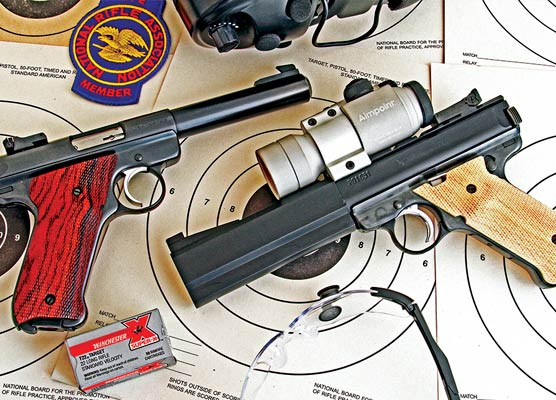Target shooting at a silhouette target could be considered practice for legitimate self defense using a firearm. The object of shooting an attacker in legitimate self defense is not to kill him but to stop his attack. A high percentage of bad guys shot with a handgun while attacking an armed good guy survive if they get medical attention reasonably quickly.
View attachment 554368
Shooting at a bullseye target is shooting for score, similar in many ways to archery. (Of course you will argue that the only use of a bow and arrow is to kill.)
If you were to mention competitive handgun shooting many years ago, no one had to ask if you meant USPSA, IDPA, PPC, cowboy action, metallic silhouette, NRA Action, fast draw, benchrest or steel speedshooting.

americanhandgunner.com
***snip***
Today, formal bullseye competition in the U.S. is governed by the National Rifle Association and called NRA Precision Pistol. The actual shooting challenge is quite simple. Stand at the firing line, hold the pistol in one hand, and fire 5- or 10-shot strings at different ranges and under different time limits.
When space permits, targets are at 50 and 25 yards. Slow Fire at 50 yards allows 10 minutes to fire 10 shots. Timed Fire at 25 yards is five shots in 20 seconds. Rapid Fire at 25 yards is five shots in 10 seconds.
About now all the action shooters are having a hearty laugh at the definition of Rapid Fire. Five shots in one second is more like it. Well, maybe, but don’t forget it’s at 25 yards and the 10-ring measures 3.36″, the tie-breaking X ring measures 1.695″. I’ve known plenty of blazing fast action shooters who at 25 yards couldn’t hit the 10-ring except by chance — if they could hit the target at all.
Three categories of handguns are recognized. These are .22 LR, “any centerfire” — minimum caliber .32 or 7.65mm, and .45 ACP. Optical sights are permitted. Matches for .22 LR-only are quite popular. A match generally consists of 30 shots — slow, timed and rapid fire — for a total of 90 shots and a maximum of 900 points.
Major matches require 90 shots with each of the three categories of handgun, for a maximum of 2,700 points — which has never been achieved in all the decades of competition. The current record, 2680-159X, was set by Hershel Anderson in 1974.]
View attachment 554377
Before it closed the Tampa Police Pistol Range required civilians to use bullseye targets. Police used silhouette targets. That range was the home of the Midwinter Pistol Match For many years.
Issuing a threat with any weapon is usually considered more serious than an empty handed threat. For example threatening a person with a knife.
Of course you have no idea how challenging shooting can be. Most people feel all you have to do is point the weapon and pull the trigger and you will hit what you are aiming at. Target shooting is not quite that simple.
I doubt with your prejudice against firearms you will be interested but perhaps others will be. The link below leads to a fascinating set of articles about the zen of bullseye pistol shooting.
Zen in the Art of Pistol Shooting
Foreword by John Dreyer
Introduction
Volumes of material have been written about acquiring proper physical technique and mental discipline in precision pistol shooting. I have found that most are tremendously valuable to any serious competitor and do a good job of describing the mechanics and philosophy of shooting. However, very few truly explored the ongoing tremendous internal battle of the competitor or the many other spiritual aspects of the sport.
In my journey from Marksman to Master, I learned a great deal about not only punching holes in paper, but about myself and my perception of life itself. Because I was unable to put together the words to relate my experiences, I sought for credible written works that properly illustrated my discoveries both on and off the range. As a result, I collected and dissected over fifty books plus almost that many articles from periodicals and other media on a variety of aspects of life and shooting. After almost a year of research and reflection, I was finally able to assemble that massive and mysterious puzzle of intellect and emotion that encompassed life both on and off the range. Surprisingly, the final piece of my puzzle turned out to be an incredibly simple way of looking at life, an ancient Eastern philosophy called Zen, a Japanese subset of Buddhist tradition.
Shooting as a Zen Art
Deceptively simple in appearance, yet vastly complex is the art of pistol shooting. Without question, its mechanics are simple. As Bill Joyner explains, "Create a machine rest with your stance, grip and breath control. Then with the gun in the machine rest, apply [trigger] pressure directly to the rear until the hammer falls." Attaining the physical prowess to accomplish this task is one thing. However, the mind's influence makes the process a bit more difficult. As Frank Higginson has said, "In shooting, you learn more about yourself than any other sport." This self-discovery that exists in shooting is nothing more than Zen itself.
While you may have thought of Zen as distant and mysterious, bear with me while I present it here in a series of diverse articles for you to explore. I encourage you to set aside any preconceived notions you have about Zen and check out these works. At minimum, you will gain insight into an aspect of competitive shooting that you may never have considered before
